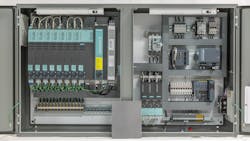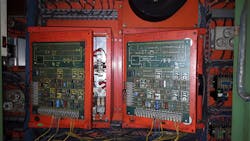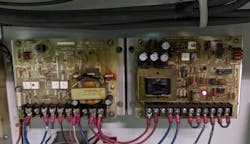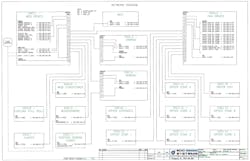Is it time to abandon your analog controls?
I have visited more than 800 manufacturing facilities, OEMs, construction sites and the occasional garage operation in my travels as an industrial controls engineer. I have not seen it all, but I have seen quite a lot. The other day I saw an AC generator set for a slitter-rewinder. Yes, this 10-person company that prints, slits and cuts paperboard for the food industry runs one of its machines with a 1950’s-era DC generator that is powered by an AC motor running across the line (full speed). The speed of the DC motor is varied by adjusting the DC field and thus the voltage to the motor. Wow! An analog DC drive would be an upgrade for these folks! Don’t fret — our firm will be helping them retrofit to an AC motor and drive.
The point is that with all this talk about automation, digitization and the Industrial Internet of Things (IIoT) there are still people using analog controls. If that is you, there are a number of benefits and opportunities for improvement that you could be missing.
Analog controls — what are they and what does that mean?
First, let’s make sure you can identify an “analog” control. This could be an old DC variable speed drive, a process control board, a signal generator or even an outdated sensor. Signs of an analog control or device include
- The circuit board may have few or no integrated circuits (IC’s).
- The drive can’t be programmed.
- Power and control boards are on one circuit board.
- Set-up and adjustments are made by adjusting small potentiometers on the control board.
- The drive or board has no communications or networking capability.
- The drive or board is manufactured before 1995.
To further aid in identifying the culprit, consider this: design of the board is analog — meaning that the circuitry that provides the means of varying the speed or controlling the process is primarily a combination of discrete devices such as resistors, capacitors, op-amps and other non-integrated electrical components. Likewise, its feedback is primitive. It may have tachometer feedback, or possibly no feedback at all. Its process regulation may be completely open loop or include only armature or “Back EMF” feedback. No pulse or networked encoders will be used here. There are also a small number of parameters that can be changed on an analog drive — usually acceleration, deceleration, gain, span, dead band, torque and maximum speed, and all must be manually adjusted by single or multi-turn potentiometers.
Another characteristic of analog controls is that the command reference signal is also analog, meaning that it is either a 0-10 Volt DC or a 4-20 mA current signal. This reference usually originates from the drive or controller itself and is proportioned using a 10K ohm potentiometer mounted externally. The analog reference signal may also come from another source, such as a PLC or closed-loop controller with an analog output that is wired to the reference analog input terminals.
Analog limitations
Analog controls are susceptible to environmental conditions because they are composed of many potentiometers, resistors, capacitors and transistors. Because resistance changes with temperature and sometimes humidity, analog systems may drift and have to be tuned for control one way in the summer and another in the winter. I have seen poorly conditioned injection molding facilities that needed hourly adjustments to their equipment in the spring and fall seasons because ambient conditions could swing wildly throughout the day.
Older analog controls do not offer the same flexibility as their digital counterparts. Because there are only a few adjustments, there are only a few things that can be optimized. As quality demands are ever increasing, variations in operating conditions often can’t be addressed. Maybe your six-sigma analysis dictates that you need to control the addition of soy milk to your gluten-free cake batter in 0.01 liters per minute and the pump you are controlling can only get you 0.1 on a good day. Certainly, there are other factors, but an analog drive may not have the resolution you need to meet your goals. Along these same lines is the lack of quick-changeover capabilities. Because the analog controls must be manually adjusted rather than programmed, your setup time may be relegated to hours rather than minutes. Think about having to reset five individual timers on a filling machine rather than having a recipe that loads what you need into PLC registers before you can say “Big Ben.”
If a single board analog control fails, it may need to be sent out for repair or be replaced. Maybe that’s no big deal if you have a 1/2 hp motor controller that you might even keep on your shelf. But if you have a 300 hp pump for a wastewater system, changing out that behemoth is going to be a daunting task. Newer digital drives typically have separate power and control boards that can be swapped out at a fraction of the cost.
Old stuff means old and difficult-to-source parts, which will likely result in extended downtime or increased cost to fix and maintain. Ever been down and had to find an obsolete board on eBay or one of the many third-party resellers of surplus or reconditioned items? No need to elaborate on this horror story.
Get on the digital bandwagon
Process manufacturing expertise today is all about communication. PLCs communicating with drives. Drives communicating with each other. Smart sensors that can be automatically set to see a blue registration mark on your labeler in the morning and a red one after lunch. A PLC that talks to remote I/O over Ethernet I/P and uses a gateway to send torque limit parameters to digital vector drives over ProfiNet. IP addresses everywhere. If you haven’t brought the digital revolution to your facility, it is time.
Ethernet, EtherCAT, ProfiNet, ProfiBus, CAN bus, and more. These communication protocols, readily available on today’s digital controls, can communicate over simple or sophisticated networks. Modern VFDs and DC drives have hundreds of parameters that can be controlled, monitored and reported back to the PLC and/or an up-stream data collection system. Parameters related to catching a spinning load, adjusting PID values on the fly or changing a drive’s carrier frequency can all be used to optimize system performance.
Factories are becoming more and more intelligent with devices and sensors that are connected to the internet and have an IP address, but how can that data be harnessed for greater manufacturing efficiency? Manufacturing intelligence allows connected devices to communicate with a central server that monitors processes and keeps managers informed as to what the system is doing. Is the control system running at peak processing speed? How often is the line running? What is the scrap rate? How much downtime versus uptime is happening? With the use of historians and data collection software, this information can be captured, saved, reported, analyzed and sent — all functions that are unavailable with analog controls.
Taking it to the next level, preventive and predictive maintenance are attainable. Trending a bearing temperature and setting an alarm for when it is out of a pre-defined range can allow a motor to run at peak performance with less downtime because the equipment’s operating information helps detect and predict problems. The bearing can be scheduled to be changed before it seizes unexpectedly and causes a bigger issue.
What am I giving up? The pluses far outweigh the minuses
All this digitalization comes at a cost of additional programming, hardware and sophistication. Analog controls are easier to get running and may be easier to troubleshoot. They may be a great fit for your application. But can you expand your capabilities? Can you afford to not go digital? How important is your process, downtime, and knowing and tracking what is happening? If you are a pharmaceutical company there are federal mandates that direct you to log just about everything that happens to your process and who makes it happen. Can you achieve the level of quality and precision you need? What production improvements and cost savings can you capture with digital controls? What is the competition doing?
How about scalability? Maybe you’re not ready to network your controls or process lines in your facility but you have installed PLCs, drives and other controls for which the networking capability is already resident or can be added with a communications card with one of the industry-standard protocols. Once you network you can add other components when and as needed.
Another advantage of digital is installation savings. A networked system of drives and remote I/O requires far less wiring than analog systems (see also Figure 4). Everything can be wired locally and communicated over an ethernet or other network using ethernet switches or even controls components that have dual embedded ethernet ports. There are a host of manufacturers that make hubs and switches that can be machine mounted and easily plugged into field devices with IP67-rated cables. If you utilize a fail-safe PLC you can connect your e-stops, light curtains and door interlocks to local safety I/O and configure your HMI/touch screen to tell you which device was tripped. No long home runs. No e-stop strings.
The cost and relative complexity of upgrading analog drives to digital is far outweighed by the many advantages and potential cost savings of having a better-controlled process.
Conclusion
There are many potential benefits of upgrading analog controls to digital. The cost of upgrading is easily recouped when the added ease of process control and potential quality improvements are considered. Other benefits include:
- Greater parts availability avoids long downtimes.
- Ability to replace individual components in the drive.
- Networking with standard industrial communications protocols.
- Highly programmable and ability to configure.
- More flexibility and greater control of the process with PID control.
- Drastically reduced changeover time.
- Storage of multiple sets of parameters for different batches/materials/set-ups.
- Reduced downtime and expense when issues are caught early.
- Preventive and predictive maintenance.
- Eliminate information lag and electrical noise issues.
- Ability to improve quality with more accurate process control.
Even if legacy analog controls are still running your manufacturing process, upgrading to digital can be a game changer. Maybe you don’t have a shiny new batch processing line or have all your VFDs on a digital network, but you can start with one piece of equipment or one section of a production line. Our friends at the paper converter will improve the quality of their slitter-rewinder process by improving its speed regulation with an AC vector drive, even in open loop mode. What could you do at your facility?
Bob Pusateri is a 30-year industrial controls veteran and is director of business development at Electronic Drives and Controls, Inc. He has held positions in engineering, sales, management and now business development for manufacturers, controls distributors and systems integrators. He is a mechanical engineer by education (Rensselaer Polytechnic Institute) and electrical engineer by vocation (lots of controls experience).
Electronic Drives and Controls, Inc.
About the Author
Bob Pusateri
Director of business development at Electronic Drives and Controls
Bob Pusateri is a 30-year industrial controls veteran and is director of business development at Electronic Drives and Controls. He has held positions in engineering, sales, management and now business development for manufacturers, controls distributors and systems integrators. He is a mechanical engineer by education (Rensselaer Polytechnic Institute) and electrical engineer by vocation (lots of controls experience).




